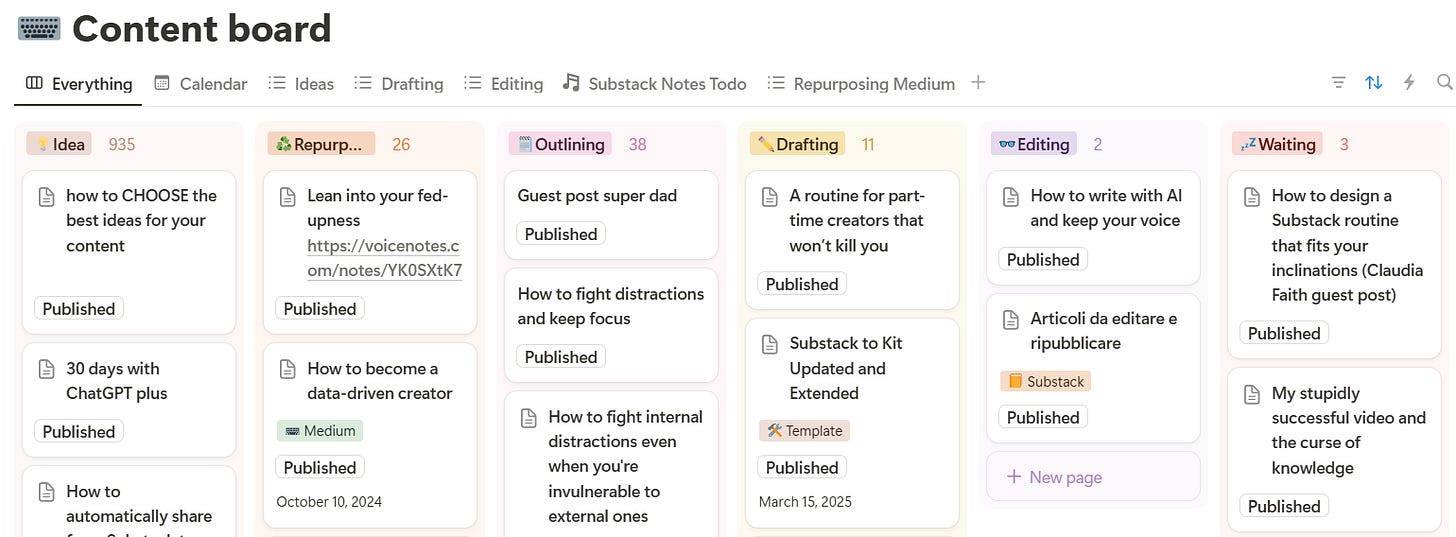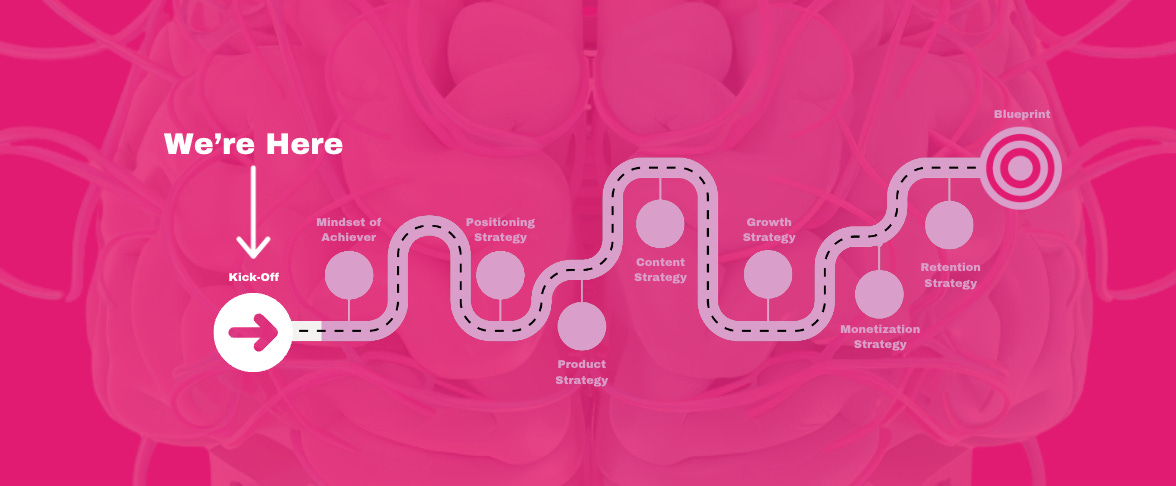Grow Your Audience Part-Time Without Losing Your Mind
A realistic weekly routine that will keep you organized and focused, even if your free time is very limited.
Today’s post is authored by
, who made me start using Notion - an app I used to persistently avoid just because I said so :)But he was so passionately talking about it that I just had to give it another try. Now Notion is my companion on my Substack Quest. Because of him.
Alberto Alberto has been a solopreneur since 2010 and is a master of productivity, strategy and mindset. His publication, The Unstoppable Creator is full of great tools, guides, mini books and templates that help you be more productive and automate stuff.
Today the focus is growing your audience on the side. I’m sure you’ll find this useful!
Every creator starts as a part-time creator.
If we can't create consistently with just a few hours each week, we'll never begin this wonderful journey. I am a full-time creator and entrepreneur, but the entrepreneur part eats up a lot of the time that I could dedicate to creating content. So I know what it means when you never have enough time to create.
I've been writing, creating videos and podcasts for 14+ years. I constantly study and talk with creators. I’ve identified the common problems and the top priorities.
If you’re a part-time creator, struggling to find the time to make a dent, here’s how to invest your limited time and energy to get the best results as quickly as possible.
How much time do you REALLY need every week?
A good practice is to publish one piece of long-form content every week. This is your cornerstone.
You could publish less frequently, but you need repetitions to improve your craft. Additionally, since you're starting from zero readers, showing up more frequently helps them get to know you better.
This long-form piece can be around 1000 words. This length allows you to deliver enough value but also to keep the attention of the reader from start to finish.
If you produce very good first drafts, you may be done in two hours from empty page to scheduled newsletter, but this is unusual. If you need to do a bit of research, add images, or clarify your thinking, you will probably spend three hours or more in the beginning writing this post.
Remember, you're writing just one piece of long-form content every week, so you need to make it count to give your audience a reason to invest their time in your writing.
But this is not enough. You need some time to attract the attention of other people and increase your subscriber base, be it through commenting or publishing short-form content or collaborating in other ways. So you'll have to spend at least one additional hour every week on these ancillary activities. The more, the better.
Finally, you need time to learn how to write, learn how to use the platform you're on, talk to your readers, and other creators.
In total, the minimum amount of weekly work is five hours, but more realistically seven hours.
You can obviously dedicate less time to your publication. But your progress will slow down.
This is not to discourage you. You may think, "There's no way I can find seven additional hours in my week."
I just believe we need to set the right expectations and face reality objectively if we want to be successful. Being delusional isn't helpful. It may fire you up in the beginning, but it will also quickly flare up and leave you with nothing but the cold feeling you can't do what you dreamed of.
Now that you know what you need, let’s see how to make this possible.
Just Two Priorities for Every New Creator
When I started blogging, I drowned in information. I love to learn, and I always second-guess myself. It proved a poisonous combination. I was pulled in a thousand different ways by contradicting guru advice.
You probably know what I mean. Everyone's recommending their recipe for success:
be everywhere
choose just two platforms
write every day
quality over quantity
quantity over quality
choose your niche
just be yourself
be persuasive
and so on.
The truth is, fortunately, that when you're starting out, your problem is also your greatest fortune: you have zero readers.
Without readers, you’re constantly shooting in the dark. You don't know if your writing is good enough. You don't know if your insights are valuable. You don't know if the topics you choose are interesting. And you absolutely can’t know what your audience would pay for.
That's why you only have one goal: attract an engaged and large enough audience. Only when you some people constantly engaging with your content, you get the kind of feedback that can help you make better decisions.
"Enough" is relative here, but as a starting point, aim at gathering at least 1000 email subscribers with an open rate hovering around 30%, and some engagement on your articles.
Until you reach this result, you can focus only on building the audience, which means two things:
writing at least one long-form piece of content every week (with a CTA to subscribe to your email list)
doing one growth-related activity, possibly daily.
Everything else is wasted effort. You can bounce back every other suggestion. You stay focused and invest your limited time in the best way.
An aside about platforms
I wasted months trying to grow on the wrong platforms. I ran a daily challenge on X that that failed horribly. I poured my heart and energy into Medium just to see it pull the rug under me.
If you’re strapped for time, this mistake can totally kill your dream of being a creator. That’s why I wrote about how to choose the best platform for you.
If you want to build an audience through your writing, your best bet right now is Substack. The platform is growing, and so is the overall audience.
Fortunately, Substack is doing a great job at giving writers great tools to not just publish but also grow organically, like recommendations and Notes. So if you publish on Substack, you don't need another platform, at least initially, unless you already have an audience there.
By the way, the principles in this guide apply also if you want to create video content. In that case, YouTube is probably the best platform if you publish long-form content, and TikTok for short-form content. Both allow you to focus on just one platform at a time because their algorithms give good organic reach also to new creators.
Organize or die
When your time is limited, working without a system is a deadly sin. Every minute counts.
The system helps you know at every moment what to work on. You don’t waste precious creative minutes deciding what you have to do or staring cluelessly at a blank page.
For example, I use a Notion kanban board to keep track of my ideas and of the writing process. Then, I make time every week to choose what to write about and to schedule the time for it over the following week.
You don't need an ultra-complicated workflow, but you need to:
save all your ideas and easily find them in the future
keep track of the progress of your articles
quickly know what you have to work on next.
Start simple, even with the basic notes app on your phone. Then adapt your system aiming for the perfect balance between complexity and effectiveness.
I wrote a mini-book about how to design your custom content creation system. You can get it here.
How do you find the time to write?
There are exceptions, but most people do their best creative work early in the morning. So, the best starting point would be to block some time for thinking and writing before work.
You can achieve a lot with half an hour of focused work every day. You can start your long-form piece on Monday and have it ready on Friday.
You can wake up a bit earlier, work in the train, go to the office earlier and shut your door, simplify your morning routine, ask the other family members for help. Try for a few weeks and adjust.
The good news is you don’t need additional time for ideation. If you write with a purpose, your mind will constantly think of your audience. You’ll see every experience and lesson learned through the eyes of your readers. Just always have a tool handy to save the avalanche of ideas surprising you in every moment.
Build it, PROMOTE IT, and they’ll come
I was lucky with my first blog. I just wrote tutorials solving common beginner photographers’ problems and saw a flood of visits from Google. Today, this is rare. You need to actively attract readers.
I hate it, too. I want to spend as little time as possible on this. So, I researched the least time-consuming tools. Here they are:
publishing short-form content,
commenting on other people’s content.
Short-form includes post on X, and LinkedIn, short videos on many platforms, and of course Substack notes. But beware, you can get viral with a couple of minutes of work. But you can also grind for months and get nothing.
To make short-form content a reliable audience growth engine, you need to constantly study what the algorithm wants, and adapt.
Commenting is different. It doesn’t make you viral, and it brings slower growth. But it has many benefits:
it gives you inspiration for your content
it allows you to create relationships with other people
it doesn't require new ideas - you just react to what other people say
it's algorithm-proof - there's no algorithm deciding whether your comments are shown to the author and his audience
it makes you build a relationship with the author, which can lead to collaborations
it gets the attention of a new audience.
You can write a short post or a comment whenever you have a break. But they work best when done consistently. So, block at least 5 minutes every day for one of them.
Your weekly schedule
If you want decent growth while you keep working full time, here’s a plan for your week:
Monday to Friday, spend 30 minutes every morning working on your next article,
Monday to Friday, spend at least 5 minutes commenting on other people’s content or writing short-form posts (at any time of day),
constantly catch the new content ideas flowing in your head.
And what about the weekends?
They can be your greatest resource, the only moment when you can have long, undivided moments for deep work. But many people can’t rely on the weekends. They are also the only moment when you can spend time with family, rest, organize social activities, and so on.
So, I wouldn’t rely on weekends to do important work, unless they are very predictable for you. Use them to do some learning, additional promotion, or writing when it’s possible.
Ready to go!
I hope this guide helped you gain clarity on what you need to do as a creator when you just don’t have time.
As a first step, try blocking some time for writing every morning next week and see how it goes.
Do you think you can do it?
P.S. Subscribe to The Unstoppable Creator for more golden nuggets like this.
Join the Substack Quest: Everything you need to grow your earnings on Substack, all in one place: courses, challenges, community, toolbox and the ultimate Substack Quest workbook!










I keep telling myself to give either Notion or Trello a real chance but I'm stuck in Google Docs and Sheets. They seem to serve my purposes for now.
Good ideas.
I start a new Word document for each idea. Then I float around them.
Pre-publishing also reduces pressure.
After a burst of activity, I am currently two months ahead with 9 completed weekly long-form posts sitting there ready to go live.
This means I can pull back to writing one long post a week. If something urgent comes up, I can publish it fast and delay a less urgent post.
I also write a daily Note about something. And I make several comments on the posts of others. I also restack a post I like most days.
Regular activity is vital, as I proved studying for two degrees while also working.
It's surprising what posts trigger responses. I just got a new paid subscriber just because I posted about a cyclone here, which I didn't expect would excite much interest, but it did. I went up 30 free subscribers in a month. Unpredictable!